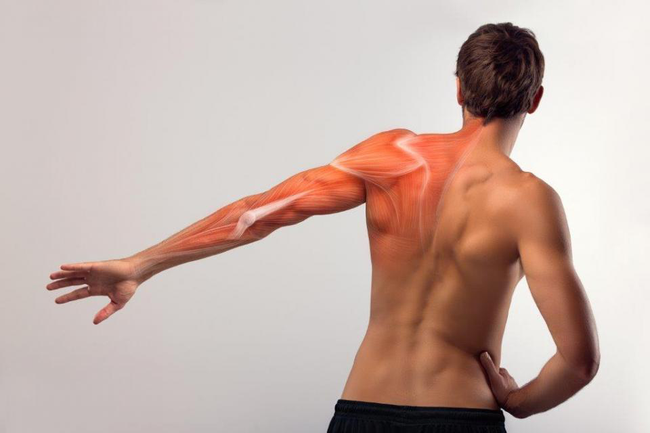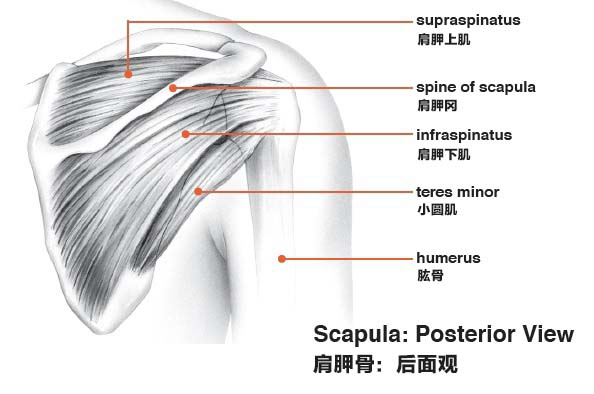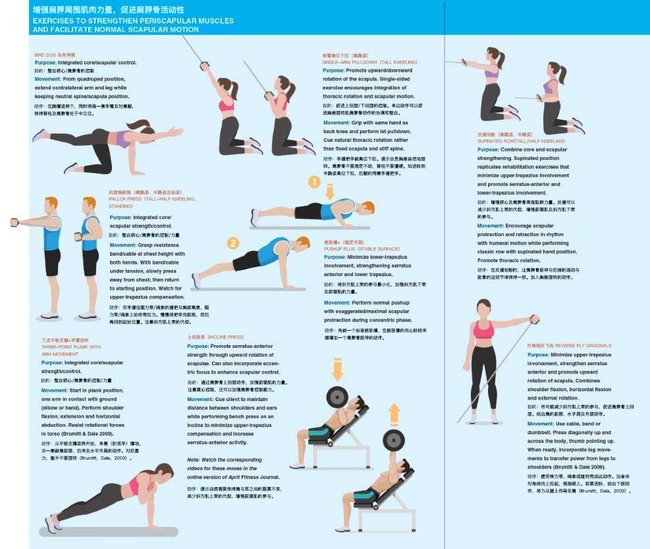肩胛骨:正确的运动
Shoulder Blades: The Right Moves
本文中,我们将学习如何辨别肩胛骨动力障碍,并提供相应的纠正性练习。
Here’s how to spot scapular dyskinesis in clients and provide corrective exercises。

肩胛骨是指尖到颈部的动力链上的重要一环。肩胛骨位置及运动的异常,称为肩胛骨动力障碍(Scapular Dyskinesis)。久坐人群更易出现肩胛骨动力障碍,触发疼痛及不适。
The shoulder blades, or scapulae, are critical links in the kinetic chain from the waist through the shoulders, up to the neck and down to the fingertips。 Abnormalities in the position or movement of the shoulder blades—technically called scapular dyskinesis—can trigger pain and discomfort, especially among people who spend long hours sitting and using computers。
超过60%的人都有不同程度的颈痛及肩痛(Cools et al。 2013)。久坐习惯是罪魁祸首,它会影响肩胛骨的活动方向、活动范围以及周边肌肉的力量。
Indeed, more than 60% of us feel neck or shoulder pain at some point in our lives (Cools et al。 2013)。 A sedentary lifestyle is one of the key culprits because it can impair scapular orientation, range of motion and shoulder muscle strength。
健身专业人士应当了解造成肩胛骨动力障碍的原因,学会如何评估症状,并给出对应的练习,帮助客户恢复肩胛骨的正常功能。想要做到这些,我们先要了解肩胛骨的正常位置及肩肱节律的有关知识。
These are crucial issues for fitness pros whose clients complain of shoulder and neck problems。 Learning the causes of scapular dyskinesis, spotting the symptoms and finding good exercise options can help restore proper shoulder blade function。 This process starts with understanding normal scapular positioning and scapulohumeral rhythm。
- 肩胛骨的作用
Role of the Scapulae
肩胛骨平整又突出的表面,是肩、颈、上背部等灵活性及稳定性的结构基础,并为力量在髋——躯干——手臂上的传导提供了稳定基础。
The flat, protruding surfaces of the scapulae provide mobility and stability to the shoulders, neck and upper back, forming a stable base for force transfer from the hips and torso to the arms。
每边的肩胛骨都有肩锁关节及盂肱关节,分别与锁骨及肱骨连接。而肩胛骨及胸椎之间缺少骨连接,拥有极大的灵活性,活动包括后缩、前伸、上提、下降、前/后倾以及上/下回旋。(Kibler, Sciascia & Wilkes 2012; Paine & Voight 2013; Voight, Hoogenboom & Cook 2008)
Each scapula has two bony attachments, the acromioclavicular joint and the glenohumeral joint。 The absence of bony articulations between the scapulae and the thorax affords great mobility, including retraction, protraction, elevation, depression, anterior/posterior tilting, and internal/external and upward/downward rotation (Kibler, Sciascia & Wilkes 2012; Paine & Voight 2013; Voight, Hoogenboom & Cook 2008)。
这么多活动度其实是一种挑战:肩胛骨的灵活性及稳定性在很大程度上取决于其周边肌肉的激活程度。离心控制极其重要,尤其是在摆臂或负重时,要通过离心控制增强肩胛骨的稳定性。(Kibler, Sciascia & Wilkes 2012)
All this flexibility poses a challenge: Scapular stability and mobility are determined largely by activation of the surrounding muscle。 Eccentric control is especially important, because it ensures scapular stability when the arm is moving, is under load or both (Kibler, Sciascia & Wilkes 2012)。
肩胛周围的肌肉对肩关节功能来说极其重要,它们需要同步、高效地协同工作,使肩胛骨做出正确的运动。前锯肌及斜方肌中下束斜方肌是肩胛骨的重要的控制肌及稳定肌(Kibler et al。 2013)。此外,肩胛骨是动力链上的重要一环,传递由髋或躯干传来的力(Voight, Hoogenboom & Cook 2008),并连接至颈椎段及胸椎段。
Thus, the periscapular muscles are vital to normal shoulder function: They must work in sync to produce efficient movement。 The serratus anterior and upper and lower trapezius are the primary contributors and stabilizers of scapular motion (Kibler et al。 2013)。 Furthermore, the scapulae coordinate with the kinetic chain, transferring forces produced in the hips and torso (Voight, Hoogenboom & Cook 2008), as well as connecting the cervical and thoracic segments of the spine (Cools et al。 2013)。
- 什么是肩胛骨动力障碍?
What Is Scapular Dyskinesis?
肩胛骨动力障碍是肩胛骨位置及运动的缺陷。下面我们聊聊如何评估它:
Scapular dyskinesis is a flaw in scapular position and motion。 Here’s how to spot it:
位置:找到内侧缘及下角(看看有没有翼状肩胛/肩胛骨前倾)
Position。 Look for prominence of the medial border and/or inferior angle (winging/anterior tilting of the scapula)。
运动:找到被打乱的肩周节律,体现为肩胛骨过早上提(耸肩)以及快速的下旋(Kibler et al。 2013)。
Motion。 Look for disrupted rhythm exemplified by early scapular elevation (shrugging of the shoulders) and rapid downward rotation (Kibler et al。 2013)。
肩胛骨动力障碍本质上不是疾病,但它与许多骨科疾病相关(Cools et al。 2013; Kibler, Sciascia & Wilkes 2012)。肩胛骨动力障碍是否引起损伤?还是仅仅反映了机体对疼痛及功能障碍的代偿?这个问题的答案尚不清楚(Kibler et al。 2013; Kibler, Sciascia & Wilkes 2012)。许多人似乎不受肩胛运动障碍的困扰,但实际上问题反应在了颈部、肩部,或造成了动力链其他环节的损伤。因此,健身专业人士应当让自己的训练损伤风险最小化,并促进肩胛骨运动的正常化。
Though scapular dyskinesis is not an injury, it is associated with many orthopedic pathologies (Cools et al。 2013; Kibler, Sciascia & Wilkes 2012)。 It’s unclear whether scapular dyskinesis causes injuries or merely reflects the body compensating for pain or dysfunction (Kibler et al。 2013; Kibler, Sciascia & Wilkes 2012)。 Though many people seem untroubled by scapular dyskinesis, the condition may predispose them to neck and shoulder pain or to injury in other parts of the kinetic chain。 Hence, exercise professionals should program suitable exercises that minimize injury risk and encourage healthy scapular motion (Cools et al。 2013)。
注意:诊断损伤及开治疗处方并不是教练的执业范围之内,一定要与医学专业人士协作。
Note: It is not within a fitness professional’s scope of practice to diagnose an injury or “prescribe” therapy。 Always work in concert with an allied medical professional。
- 识别肩胛骨动力障碍
Looking for Scapular Dyskinesis
观察肩胛骨的活动是识别肩胛骨动力障碍的较为可靠的方法之一(Kibler, Sciascia & Wilkes 2012)。下面给出的测试方法相当可靠(McClure et al。 2009):
Observing the shoulder blades in motion is a reliable way to identify scapular dyskinesis (Kibler, Sciascia & Wilkes 2012)。 The following test is reasonably reliable (McClure et al。 2009):
- 让客户双手各拿3-5磅(约35-2.25公斤)的重物,双手同时前平举举到最高位置,然后慢慢放下,做5次。
- Have the client hold a 3- to 5-pound weight in each hand and raise and lower both arms slowly in forward flexion to maximum elevation 5 times。
- 让客户双手各拿3-5磅(约35-2.25公斤)的重物,双手同时外展到最高位置,然后慢慢放下,做5次。
- Repeat the process for shoulder abduction (frontal plane)。
- 观察每边肩胛骨的运动,注意内侧缘及下角是否翘出。以及是否有节律障碍,具体表现包括肩胛骨过早抬高、出现多余活动、快速下旋或耸肩等(Cools et al。 2007)。
- Observe each scapula’s motion, watching for medial-border/inferior- angle prominence and dysrhythmia, includ ing premature elevation, excessive motion, and/or rapid downward rotation or shrugging of the shoulders (Cools et al。 2007)。
- 选择练习动作
Looking Choosing Exercises
在引入复杂的多关节、有负重的手臂练习前,应当先增强肩胛骨稳定肌肌力,改善肩关节近端稳定性(Kibler & McMullen 2003; Kibler & Sciascia 2010)。下列是肩胛骨动力障碍时最常见的动作模式代偿:
Exercises should emphasize proximal stability by strengthening the scapular stabilizers before incorporating complex loaded-arm exercises into a strengthening program (Kibler & McMullen 2003; Kibler & Sciascia 2010)。 These are the most common motor-pattern alterations in scapular dyskinesis:
- 斜方肌上束过度激活
- increased activation of the upper trapezius
- 斜方肌下束激活延缓
- delayed activation of the lower trapezius
- 前锯肌及斜方肌下束较弱
- weakness in the serratus anterior and lower trapezius
因此,选取的动作应当能够增强斜方肌下束及前锯肌的激活,同时降低斜方肌上束的激活程度,促进正常肩胛骨运动的形成。(Kibler et al。 2008)
Therefore, select exercises that emphasize lower-trapezius and serratus-anterior activation while diminishing upper-trapezius activation and promoting normal scapular motion (Kibler et al。 2008)。
我们建议通过做俯卧撑来加强前锯肌及斜方肌下束。如果在俯卧撑的向心阶段末端增加一个肩胛骨前伸的动作,可以取得更好的效果。这个动作称为“俯卧撑+(Pushup Plus)”,文章结尾附有视频。
Pushups are suggested for strengthening the serratus anterior and lower trapezius, especially when exaggerated scapular protraction is added at the end of the concentric phase (the “pushup plus”)。
一项2014年的研究指出,有肩胛骨动力障碍的受试者在不稳定平面上做俯卧撑,比在稳定平面上做时,斜方肌上束的激活程度更高。而对于没有肩胛骨动力障碍的受试者,结果正好相反。这意味着在不稳定平面上训练会增加神经肌肉需求,有肩胛骨动力障碍的个体会出现代偿模式。
A 2014 study found an unfavorable increase in upper-trapezius activity in those with scapular dyskinesis when the pushup was performed on an unstable surface versus a stable surface。 The opposite is true for subjects displaying no dyskinesis, suggesting that increased neuromuscular demands from an unstable surface enable the compensatory patterns seen in clients with scapular dyskinesis (Priauá et al。 2014)。
肩胛骨控制不是孤立的,它与其他部分联动。伸髋、躯干伸展以及躯干旋转会促使肩胛骨后缩,来到一个更稳定的位置。因此,我们应当引入一些增强核心和腰椎骨盆稳定性,以及适当的脊柱灵活性的练习。练习应当在无代偿动作的前提下,模拟日常及专项活动,形成较好的肌肉募集模式(Cools et al。 2007)。文章结尾处的“一些加强肩胛周围肌群、促进正常肩胛运动形成的练习”一栏中,我们给出了一些针对性练习动作。
It is important to remember that scapular control is part of a larger system。 Hip and trunk extension and trunk rotation promote a more retracted and stable scapular position。 Therefore, incorporate exercises that promote core and lumbopelvic stability and appropriate spinal mobility。 Exercises should promote normal muscle-recruitment patterns that mimic daily or sport-specific activities without compensatory strategies (Cools et al。 2007)。 The sidebar “Exercises to Strengthen Periscapular Muscles and Facilitate Normal Scapular Motion” identifies suitable exercises to strengthen periscapular muscles and promote healthy scapular motion within the kinetic chain。

- 专业建议
Professional Recommendations
教会客户如何正常地活动肩胛骨。例如在划船动作教学中,示范正确的肩胛骨前伸和后缩。叮嘱客户在做动作时放松肩膀,不要耸肩,将斜方肌的代偿模式最小化。尤其是带久坐客户训练时,可以尝试在高跪或半跪姿势下做动作,增加核心肌群的参与。(Voight et al。 2008)
Teach clients how to move the scapulae naturally。 You can demonstrate proper protraction and retraction during a rowing exercise, for example。 Encourage clients to relax their shoulders—rather than shrugging—to minimize upper-trapezius compensatory patterns。 It’s also a good idea to perform exercises in a tall/half-kneeling or standing position to increase core muscular activity (Voight et al。 2008), especially for clients who spend most of their days seated。
在热身时加入一些康复性的练习,可以激活肩胛骨稳定肌,促进肩胛骨的正常运动,为之后的练习做好准备。如果客户出现疼痛,将客户移交给医疗人员(如物理治疗师)进行诊断和治疗。
Incorporating rehabilitation exercises into a warmup routine can prepare the scapular stabilizers for exercise and reinforce healthy motion。 If your clients are in pain, refer them to an appropriately trained healthcare provider, such as a physical therapist, for evaluation and treatment。
- 总结
Better Shoulder Blades
肩胛骨动力障碍不一定意味着损伤。肩胛骨是动力链上的重要一环,想要保证肩胛骨功能正常,就要选择正确的练习。首先对肩胛骨的功能进行评估,发现问题。然后针对评估结果,选取适当的练习,增加肩胛骨及核心控制能力。然后进阶到多关节、功能化的动作练习,模仿日常或专项中的肌肉募集模式。
It’s true that scapular dyskinesis does not guarantee injury。 Nevertheless, normal scapular function is a vital link in the kinetic chain, so it’s important to select exercises that encourage healthy scapular motion。 Start with assessments to determine the presence of dyskinesis。 Once you have identified any issues, choose exercises that enhance proximal control of the scapulae and core muscles。 Then progress to incorporate functional, multijoint movements with normal muscle-recruitment patterns。
- 一些加强肩胛周围肌群、促进正常肩胛运动形成的练习
Exercises to Strengthen Pariscapular Muscles and Facilitate Normal Scapular Motion

- 附录
(4个视频)
l 参考文献Reference
Brumitt, J。, & Dale, R.B。 2009。 Integrating shoulder and core exercises when rehabilitating athletes performing overhead activities。 North American Journal of Sports Physical Therapy, 4 (3), 132–38。
Cools, A.M。, et al。 2007。 Rehabilitation of scapular muscle balance: Which exercises to prescribe? American Journal of Sports Medicine, 35 (10), 1744–51。
Cools, A.M。, et al。 2013。 Rehabilitation of scapular dyskinesis: From the office worker to the elite overhead athlete。 British Journal of Sports Medicine, 48 (8), 692–97。
Kibler, W.B。, & McMullen J。 2003。 Scapular dyskinesis and its relation to shoulder pain。 Journal of the American Academy of Orthopedic Surgeons, 11 (2), 142–51。
Kibler, W.B。, & Sciascia, A。 2010。 Current concepts: Scapular dyskinesis。 British Journal of Sports Medicine, 44 (5), 300–05。
Kibler, W.B。, et al。 2008。 Electromyographic analysis of specific exercises for scapular control in early phases of shoulder rehabilitation。 American Journal of Sports Medicine, 36 (9), 1789–98。
Kibler, W.B。, et al。 2013。 Clinical implications of scapular dyskinesis in shoulder injury: The 2013 consensus statement from the ‘scapular summit。’ British Journal of Sports Medicine, 47(14), 877–85。
Kibler, W.B。, Sciascia A。, & Wilkes, T。 2012。 Scapular dyskinesis and its relation to shoulder injury。 Journal of the American Academy of Orthopedic Surgeons, 20 (6), 364–72。
McClure, P。, et al。 2009。 A clinical method for identifying scapular dyskinesis, part 1: Reliability。 Journal of Athletic Training, 44 (2), 160–64。
Paine, R。, & Voight, M.L。 2013。 The role of the scapula。 International Journal of Sports Physical Therapy, 8 (5), 617–29。
Priauá, A.L。, et al。 2014。 Electromyographical analysis of the serratus anterior and trapezius muscles during push-ups on stable and unstable bases in subjects with scapulae dyskinesis。 Journal of Electromyography and Kinesiology, 24 (5), 675–81。
Voight, M.L。, Hoogenboom, B.J。, & Cook, G。 2008。 The chop and lift reconsidered: Integrating neuromuscular principles into orthopedic and sports rehabilitation。 North American Journal of Sports Physical Therapy, 3 (3), 151–59。
作者: Erin Lyons, Jason Lunden 以及 Eddie Davila, MS
译者:赵鹏旺


